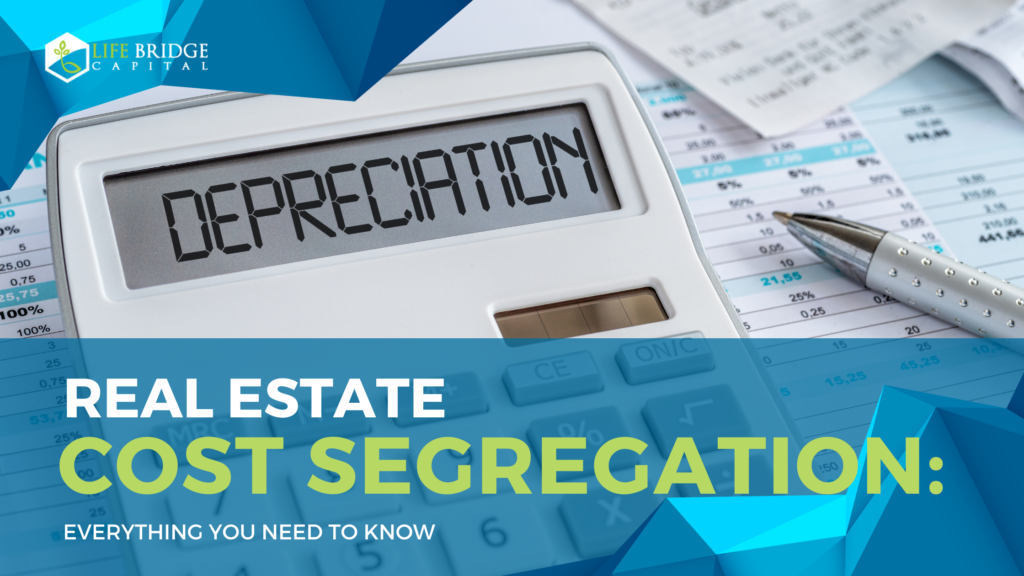
Not only does real estate allow investors to stay ahead of inflation and make substantial passive income, but they keep more of the money they earn through several tax advantages. Cost segregation is one method for further maximizing profit via savvy tax maneuvers.
Life Bridge Capital is a leading real estate syndication company. We offer our investment partners the opportunity to leverage shares of multifamily rental properties into a passive monthly income. Learn More
What is Cost Segregation?
Cost segregation involves reclassifying certain types of property to increase deprecation, and consequently, reduce taxable income.
Depreciation is a tax construct based on the finite usable lifespan of structures and other assets on a property. Each year, the property owner gets to deduct the ‘used up’ portion as a depreciation expense.
The lifespan used to calculate depreciation for residential properties is 27.5 years, and for commercial property, it is 39 years. However, provisions in the 2017 Tax Cuts and JOBS ACT make it possible to accelerate the timeline for taking the depreciation deduction. Then, on top of that, we use cost segregation to speed up the depreciation schedule even further.
How to Calculate Depreciation
There are multiple methods for calculating depreciation, but the straight-line method is the most common. It yields a consistent depreciation deduction each year of the asset’s usable life. To calculate depreciation using this method, simply divide the purchase price, excluding the land value, by the allowable number of years as determined by the IRS.
Remember, total depreciation will never equal the full purchase price of a property. This is because the value of the land itself is not subject to depreciation. After all, the land is considered to last forever. So, one could depreciate the purchase price minus the land value over the 27.5 or 39-year schedule.
Additionally, the IRS allows owners to break down the asset type further. This is where cost segregation comes in.
Using Cost Segregation to Accelerate Depreciation
Cost segregation breaks assets up into more specific categories rather than lumping the entirety of a property and its contents into the 39 or 27.5-year depreciation schedule.
The IRS classifies property into four different types:
- Land, which cannot be expensed.
- The building depreciates over 39 or 27.5 years, depending on whether it is for commercial or residential purposes.
- Improvements are expensed over 15 years. Things like sidewalks and fences are considered improvements.
- Personal property may be expensed over 5 or 7 years.
The goal of cost segregation is to increase the immediately available depreciation deduction. For example, using cost segregation, a $20,000 furniture expense can be divided among five years for a $4,000 deduction each year. Alternatively, that would only be a $727 deduction over 27.5 years.
What is the Benefit of Accelerating Depreciation Using Cost Segregation?
There are several reasons to pursue cost segregation. Generally, real estate investors prefer accelerated depreciation because they may not hold a property for more than a few years. In those situations, they are essentially leaving money on the table when they fail to use the entire depreciation deduction, which frequently happens when depreciating assets like improvements and personal property on a lengthier timetable.
Alternatively, cost segregation and accelerated depreciation are especially beneficial if you expect to replace the item before it fully depreciates. Many things, like furniture and electronics, do have a comparatively short usable life. You will replace them in the foreseeable future, and their replacements will bring a new opportunity for a depreciation deduction.
Perhaps most importantly, consider that a reduced tax burden now leaves more money in your pocket. Cost segregation can reduce taxable income by hundreds of thousands of dollars when high-value properties are involved. That money saved can immediately be put toward your next investment.
Finally, keep in mind that the tax code can change, sometimes without substantial notice. Thus, an opportunity that we have now, like cost segregation, may terminate at any time. For that reason, many investors prefer to take any available deduction immediately rather than save it for a future tax year.
Of course, cost segregation is not the best choice in every situation. For example, some owners rely on a consistent depreciation deduction each year to reduce the tax burden. If you have no plans to make expensive purchases that will yield additional depreciation deductions, cost segregation may not be beneficial.
Final Thoughts
Before using cost segregation to accelerate depreciation for your property, engage the services of a professional to create a cost-segregation study. Cost segregation studies are completed by a team of accountants, lawyers, and engineers. It not only helps you maximize your possible depreciation deduction but also serves as a safety net should the IRS question your classifications.
Life Bridge Capital is a leading real estate syndication company. We offer our investment partners the opportunity to leverage shares of multifamily rental properties into a passive monthly income. Learn More


